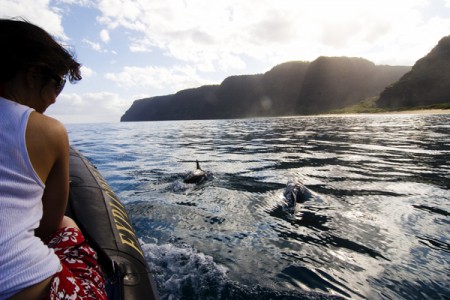When you go off on a guided tour with a bunch of people the biggest decision you can make is where to sit. On the left? On the right? Up front? In the back? Sooner or later I’m going to realize that whatever my instincts tell me, I should do the opposite. Yesterday as we boarded our Na Pali Explorer 26-foot Rigid Inflatable Boat (better known as a RIB), I scurried to sit way up front. The better to, you know, see where the hell we were going. But the thing is that the nose of a RIB is the part that shoots way up over the crest of a wave and then slams down hard moments later. People in the back don’t even notice. I’m hanging on for dear life and they’re snoozing.
Oh well. At least I was the first to spot the pod of spinner dolphins that appeared as if out of nowhere right in front of us. We cut the engine and just bobbed up and down in the chop while the spinners put on a show for us, leaping into the air just feet away from our RIB and making spectacular mid-air spins (which is why they’re called “spinner dolphins,” right?).
These dolphins, which are pretty common in Hawaii, tend to hang out at night in herds of as many as 200 animals in the deep channels between the islands where they feed. Then in the morning, they break up into smaller groups and play in the morning and rest in the afternoon (if they liked cocktails, it would be my idea of the perfect life). So why do they jump out of the water and make these acrobatic moves? No one knows exactly, but I have to think that part of it is they’re just having fun. You know the joke about why dogs lick their nuts? Well, I’d say the punchline is the same for why spinner dolphins spin in the air—because they can.
What was really neat about these guys, besides all the acrobatic moves, was that there were a fair number of calves, some no bigger than a large loaf of bread, in this group. According to our guide, these babies are born tail-first with eyes wide open, and with enough muscular coordination to follow their mothers immediately. For the next year and a half to two years, they nurse on mom. Somewhere along the line, they dine on their first anchovy. That must be a rude experience after two years of mother’s milk.
What’s also interesting is that the young dolphin will stick with mom for anywhere from three to eight years before finally venturing off on their own. That’s a big variable. I guess just like people, some dolphins are just mama boys.


Recent Comments